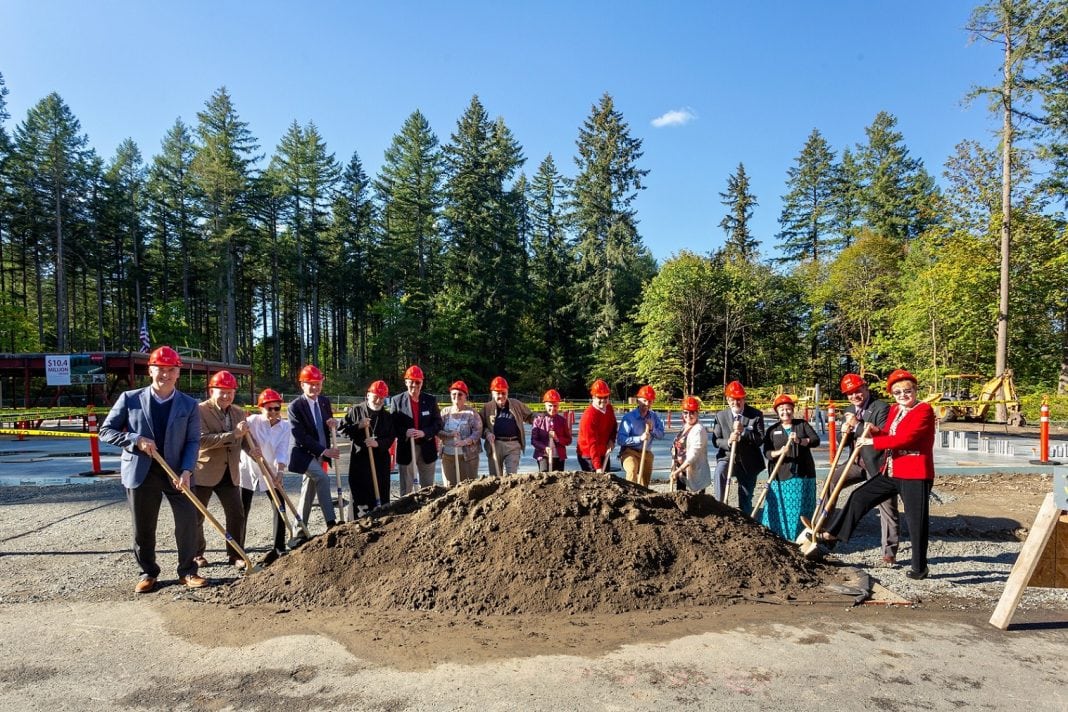Saint Martin’s University has long been recognized as a regional jewel. This year, they again made the list of U.S. News and World Report’s Best Colleges. With nearly 125 years teaching, guiding and caring for the community, they’re not slowing down one bit.
Acknowledging the groundbreaking research that happens daily in STEM fields, they’ve done a little ground breaking of their own. On Monday, September 17, faculty, staff, students, donors and trustees met to break ground on the school’s new 30,000-square-foot science building. The culmination of a comprehensive Science Initiative, the new building will be completed and open its doors to students in 2019.
U.S. News also reported that, “The survey of 2,000 Americans also showed that students are now twice as likely to study STEM fields compared to their parents, and 52 percent of parents surveyed said they think there will be more and more STEM jobs in America in the next 10 years.” By adding more high-quality STEM offerings, SMU has cemented its place on the list.

The Federal Economic and Statistics Administration reports that, “Employment in STEM occupations grew much faster than employment in non-STEM occupations over the last decade (24.4 percent versus 4.0 percent, respectively), and STEM occupations are projected to grow by 8.9 percent from 2014 to 2024, compared to 6.4 percent growth for non-STEM occupations.”
The new building promises 12 new research labs, 10 classroom instructional labs, as well as nuclear magnetic resonance, instrument, and dry labs. The University is excited to join “a national movement to increase America’s science and math graduates. The jobs of tomorrow are already here today, and many of those jobs in our region are going unfilled. Washington State has one of the highest concentrations of STEM jobs in the country, but we are one of the lowest states for producing these graduates. Saint Martin’s new science building will be strategically located next to Cebula Hall and the Panowicz Foundry, creating a STEM triangle on campus.”
“We’ve been in need of updated and upgraded science facilities for a long while now,” says Aaron Coby, associate dean of the College of Arts and Sciences and associate professor of biology. “The science and engineering programs have been growing rapidly in recent years, but the facilities are the same ones we had when there were only 20 biology majors. This semester we have about 145 biology majors.”

Associate Professor of Chemistry and Chair of the Department of Natural Sciences Gregory Milligan is also excited for the expansion. “Our students will be the direct beneficiaries of these new opportunities, such as modern lab infrastructure, easier scheduling of classes, and support for our new Environmental Studies and proposed Exercise Science programs. The building was designed with extensive faculty input and will provide facilities that will allow us to take our teaching and research to a new level of excellence. We are very grateful to the donors who are providing the funding for the building, and to the people at Saint Martin’s who have worked so hard to make the project happen.”
At the groundbreaking ceremony, Board of Trustees member John Carr, who worked as a manager and scientist at DuPont Agricultural Chemical before his retirement, honored Saint Martin’s history and outlook. “We offer that nourishing environment,” he says. “Taking students and making the best of them.”
Fellow Board member George Parker, technical fellow and technical lead engineer at Boeing, agreed that it was time to expand. Previously, classes were held in Old Main. “We had fun in that building, and it was hard,” he recalls. But having a cutting-edge, dedicated space allows student scientists “the opportunity to do true research.”
Jeff Crane, dean of the College of Arts and Sciences, interim dean of the School of Business, and professor of history, hopes faculty advancement will take place alongside student success. “This will be the site of increasing faculty research and collaboration,” he says, which serves to raise the school’s profile, bring in grant funding, increase enrollment, and support other existing majors.

The ceremony closed with a prayer and blessing by Abbot Neal Roth. The Abbot forgot his holy water but chuckled that “I think we’ve been blessed with enough water lately” as bystanders avoided puddles on the freshly-poured foundations.
Cecelia Loveless, vice president of institutional advancement, then offered shovels and commemorative red hard hats to dignitaries. After the groundbreaking, guests were invited to sign their names on a key structural beam before it was set into place.
You can donate to the Science Initiative online or watch videos explaining the importance of the new building. Then schedule a visit to the Lacey campus where you’ll see all the ways Saint Martin’s is breaking new ground in education.
Sponsored



































